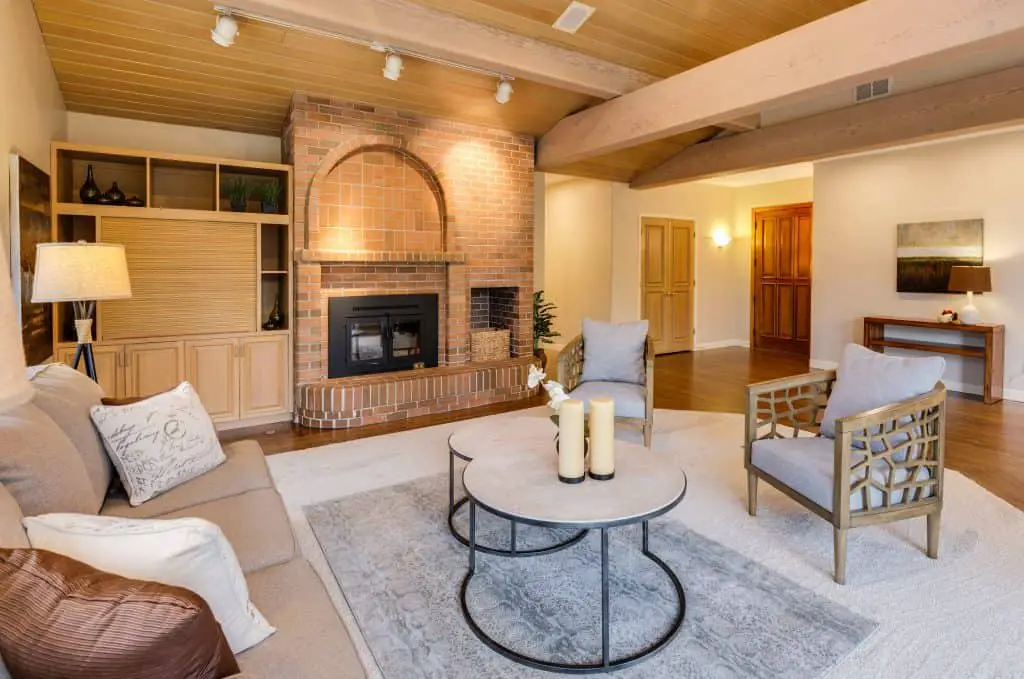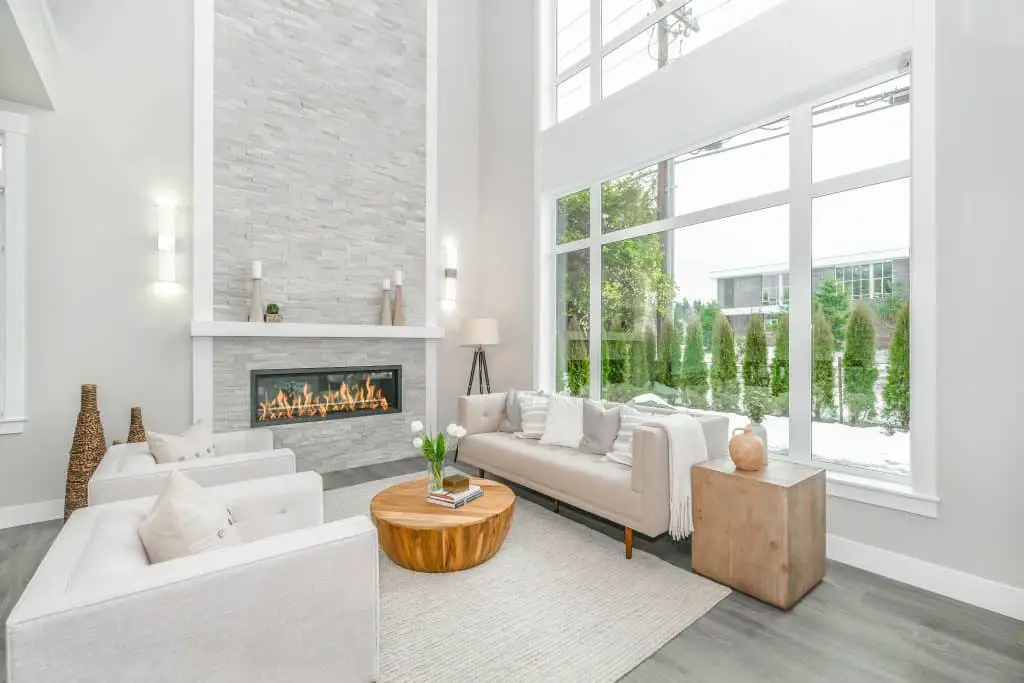A fireplace surround is a thrown-together word for everything that surrounds a fireplace. Think of the mantel and legs, for example. But since these parts sit relatively close to the firebox, how hot does a fireplace surround get?
A fireplace surround will always be warm to touch, as it is located against the firebox. However, fireplace surrounds should never be too hot to touch. Surrounds are made of many different materials, including wood, so they should not get too hot to the point of possible combustion.
Fireplace surrounds typically don’t get to the point where they’re too hot to touch. But how hot they get will vary depending on several factors. In this article, we’ll go over all of these factors, and we’ll also discuss how much heat the most popular materials for fireplace surrounds can take!

How Hot Does A Fireplace Surround Get?
A fireplace surround is warm to touch, but never to the point where it’s too hot. How hot a surround exactly gets depends on how much clearance there is, what type of fireplace you have, and what kind of fuel you are burning.
How hot a surround exactly gets is dependant on several factors. The most important one is the distance, or clearance, between the firebox and the surround. Obviously, the closer the surround is to the firebox, the hotter it will be.
A surround is an informal name that basically compiles everything that surrounds the fireplace. This includes the mantel and legs. We also have an article on how hot mantels get and how much heat they can take. You can find that article by following this link!
But the type of fireplace, and even the type of fuel you’re burning, plays a significant role in how hot a surround gets. Different types of wood burn at different temperatures, and there’s a substantial difference between gas, electric, and wood-burning fireplaces. Let’s dive into these factors!
Clearance
Clearance is the distance between the firebox, the part where the fire is, and the surround. The closer the surround is to the firebox, the warmer the surround will be. Because surrounds can be made of combustible materials, there are several rules and codes you should adhere to.
Typically, a surround should be at least 6 inches away from the firebox. On top of that, every 1/8 inch that the surround protrudes should be met with another inch of clearance. Since most mantels protrude into the room, the standard clearance for a surround is 12 inches.
The correct clearance is especially important for surrounds made of combustible material. Wooden surrounds are very popular, but wood is a flammable material. To play it safe, you should always meet with the minimum clearance codes, but definitely don’t be afraid to add a few extra inches of clearance.
Type Of Fireplace
The type of fireplace plays a significant role when it comes to heating up a surround. Every type of fireplace (gas, electric, and wood-burning) gives off a different heat level.
- Electric fireplaces typically don’t give off heat. In the cases that they do, they usually give off about 5000 BTUs, which is enough to heat a room of 400 square feet, but not enough to heat up a mantel too much. Electric fireplaces are typically considered to be the same as oridnary heating appliances.
- Gas fireplaces burn gas and can reach up to 1000 degrees Fahrenheit. This is not enough to overheat a surround, but it can lead to the mantel being hot to touch. Gas fireplaces are known to be the safest type of fireplace, as a gas burn is extremely controlled.
- Wood-burning fireplaces can reach temperatures between 1000 and 2000 degrees Fahrenheit. How much comes down to the type of wood your burning (more on that later!), but it’s safe to say that a wood-burning fireplace heats up the mantel the most.
Type Of Fuel
Every type of wood burns at a different temperature. Hardwoods tend to burn a lot slower, which leads to a much higher temperature. Here is a brief rundown of the most popular types of firewood and how hot they burn:
How Hot Certain Woods Burn
As you can see, the temperatures vary widely. Still, even at 1832 degrees Fahrenheit, the mantel should not overheat. With the correct clearance, a mantel should always be safe, no matter the temperature inside the firebox.

Is It Normal For A Fireplace Surround To Get Hot?
Since the surround is located against the firebox, it is normal for a surround to get hot. However, fireplace surrounds shouldn’t reach too high temperatures. It should always be warm to touch, but never too hot.
It’s perfectly normal for a surround to heat up. After all, it’s a part of the fireplace that sits relatively close to the actual fire. Naturally, things close to fire heat up.
What isn’t normal, however, is when the surround starts to heat up so much that you can no longer touch it. Something is hot to touch when it reaches a temperature of 150 degrees Fahrenheit. A mantel (the main part of a surround) is usually made to withstand 185 degrees Fahrenheit, but should you usually be well below that.
When you notice that the mantel starts to become too hot, you know there’s something up. An overheating mantel is usually a sign of a defect within the fireplace. Maybe something’s installed incorrectly. In that case, you should contact a professional to have your fireplace checked out.
How Much Heat Can Certain Types Of Fireplace Surrounds Take
Not every material can take as much heat as the other. Here, we’ll cover some of the most popular materials used for fireplace surrounds and how much heat they can handle!
Wooden Fireplace Surrounds
Wood will ignite with temperatures of 500 degrees Fahrenheit. And as we saw above, both wood and gas fireplaces will burn at 1000 degrees Fahrenheit or more.
Luckily, that’s the temperature of the fire and not the surrounding areas. A fireplace surround usually doesn’t get warmer than 185 degrees Fahrenheit, so you’re more than safe.
Stone Fireplace Surrounds
Stone is one of the best materials to go for if you’re worried about possible combustion. It needs to reach degrees between 1100 and 2400 degrees Fahrenheit before it starts to deteriorate and melt.
Mantels typically don’t warm up over 185 degrees Fahrenheit.
Steel Fireplace Surrounds
Steel can withstand 750 degrees Fahrenheit before it starts to deteriorate. With fireplace surrounds not heating over 185 degrees Fahrenheit, a steel surround is perfectly safe.
Concrete Fireplace Surrounds
Concrete can withstand 200 degrees Fahrenheit before it starts to deteriorate. This makes concrete the option that can withstand the least amount of heat, making it the worst material to use.
Still, surrounds will heat up to 185 degrees Fahrenheit at maximum, so concrete is still fine, but it does come close to the maximum temperature.
Tile Fireplace Surrounds
Tile surrounds can take heat up to 2200 degrees Fahrenheit. Just like with stone, there is absolutely no reason to worry about a tile surround overheating.
How Much Heat Certain Surround Materials Can Take

